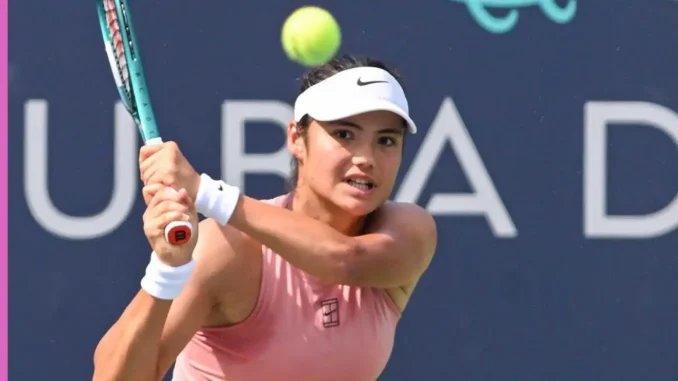
As the tennis season winds through Asia’s late-year heat, players are finding themselves locked in battle not just against rivals across the net, but against the punishing forces of nature itself. The recent Ningbo Open in China, a WTA 500 tournament known for its sticky humidity and intense atmosphere, became the latest proving ground in this struggle. On October 17, 2025, local wildcard Zhu Lin stunned British star Emma Raducanu with a 3-6, 6-4, 6-1 victory in the second round. Yet the real headline wasn’t the scoreline—it was Raducanu’s visible fight against the suffocating conditions, reigniting debate over player safety and the sport’s handling of extreme weather.
The 22-year-old former US Open champion entered Ningbo riding high after a strong quarterfinal showing in Seoul, appearing ready to finish her Asian swing on a high note. But as the temperature soared to around 32°C (90°F) with thick humidity, Raducanu began to fade. Her energy drained with each rally, and by the deciding set, her movements slowed to a near crawl. Battling both Zhu’s relentless groundstrokes and the stifling air, Raducanu appeared physically spent. Afterward, she withdrew from upcoming events in Tokyo and Hong Kong on medical advice, citing exhaustion and dehydration—an unmistakable sign of how brutal the conditions had become.
It wasn’t the first time Raducanu had suffered under extreme heat. The Brit, who has overcome surgeries and recurring injuries, has repeatedly voiced concerns about the growing physical demands of the tour. Speaking after her Ningbo defeat, she described the ordeal in vivid terms: “The heat here is just brutal—it’s like playing in a sauna. You try to focus, but your body gives out. Sweat burns your eyes, your legs feel like concrete. We need better protections; otherwise, this becomes dangerous.” Her remarks echoed sentiments heard across both tours as climate extremes increasingly disrupt tournaments from Melbourne to New York.
Among those moved by Raducanu’s experience was Italian star Matteo Berrettini. The 29-year-old, fresh off a resurgence following a long injury layoff, used a recent exhibition in Verona to demand a rule overhaul. “People underestimate how much difference a few degrees make,” he said passionately. “We’re not machines. Watching Emma push through that match was tough—you could see she was suffering. If the ATP waits until someone collapses, it’ll be too late. We need mandatory heat rules now—timeouts, suspensions, whatever keeps players safe.”
The WTA has long employed a “heat rule” that allows match suspension when the wet-bulb globe temperature—a measure factoring in humidity, wind, and radiation—exceeds a dangerous threshold. But its enforcement remains inconsistent worldwide. Some tournaments offer cooling zones and hydration breaks; others rely on local discretion. The result is a patchwork system that leaves players exposed depending on where they play.
Berrettini’s appeal mirrors growing unrest among top athletes. Carlos Alcaraz, who endured grueling heat during his French Open run earlier this year, has also called the sport’s schedule “inhuman.” “This calendar is insane,” he said. “We’re flying from continent to continent with barely time to recover. In this kind of heat, it stops being tennis—it’s survival.” His frustrations have been echoed by Jannik Sinner and Iga Swiatek, all pointing to the same concern: a tour that pushes players to the limit with little adaptation to environmental realities.
The Players’ Council is reportedly set to discuss these issues at its November 2025 meeting in London, with proposals for universal temperature thresholds, longer rest intervals during extreme conditions, and smarter climate monitoring at venues. Berrettini, a council member, hopes Raducanu’s case becomes the tipping point. “She’s not asking for sympathy,” he said. “She’s exposing a systemic flaw. We can’t just hope players cope—we have to act.”
For Raducanu, recovery now takes precedence. Back home in London, she’s regrouping under new coach Francisco Roig, focusing on tactical growth and long-term resilience ahead of the 2026 season. Her withdrawal from Asia’s closing stretch was a setback, but also a necessary reset. Her story, however, has become symbolic—of a sport caught between tradition and a changing planet.
Once confined to temperate courts in Europe and America, tennis is now a year-round global enterprise, subject to heatwaves, altitude, and unpredictable climates. Berrettini’s call for reform, bolstered by Raducanu’s honesty and Alcaraz’s fire, signals that players are ready to confront the problem together. “We’re all sweating through the same struggle,” Berrettini quipped. If their voices spark action, the sport could soon see matches paused for safety, players cooled and rehydrated, and a fairer balance between performance and protection.
As the 2025 season winds down, one message rings clear: in a world of rising temperatures and relentless schedules, tennis must evolve—or risk burning out its brightest stars.
Leave a Reply